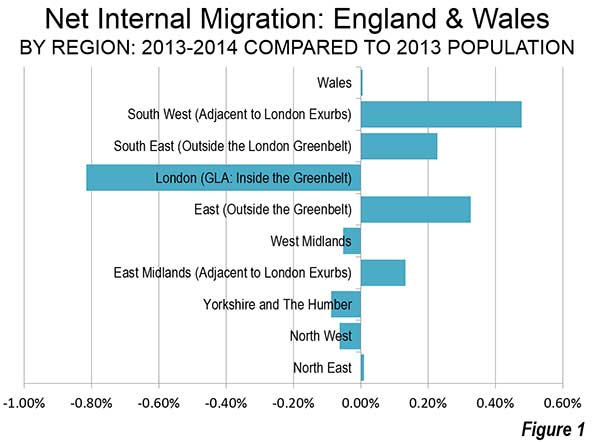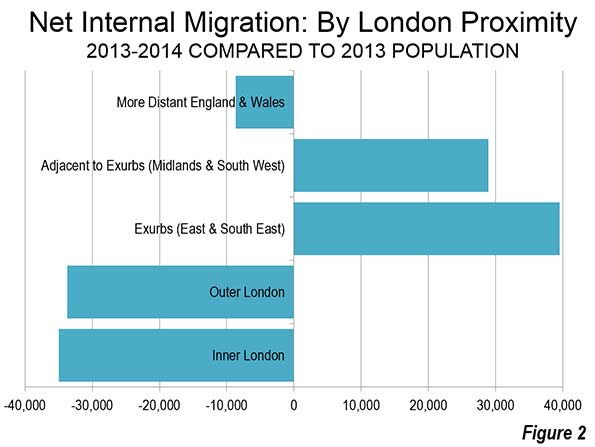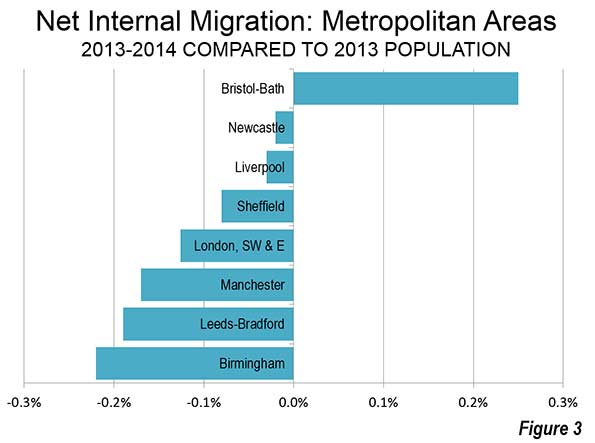
A review of the most recent internal migration (domestic migration) in England and Wales reveals some surprises. The latest data covers the one year ended June 30, 2014. It was published by the Office of National Statistics (ONS) and provides estimates at least down to the local authority area (municipality). In this regard, is positioned along with a number of European nations and the Australian Bureau of statistics well ahead of the US Census Bureau, which provides estimates only to the county level.
The Regions
On a regional level, there was little movement outside the southern half of England. England is divided into nine regions. Three of the northern and middle regions lost modest numbers of internal migrants, ranging from a minus 0.05% (minus 3,000 people) in the West Midlands, which contains England's second largest city, Birmingham. There was loss of 0.06% (minus 7,100 people) in the North West, where Manchester and Liverpool are located. There was a 0.09% loss (minus 4,700 people) in Yorkshire and the Humber, where Leeds and Sheffield are located (Figure 1).
The North East, which contains the city of Newcastle, has long been an area of economic hardship and is of danger of becoming "Britains Detroit" according to The Guardian. Yet the North East experienced a small gain of 0.01% in internal migrants (500 people). The largest gain outside southern England was in the East Midlands, which includes Leicester and Nottingham, attracted a net 0.13 percent in new migrants (6,200 people). Wales (largest city Cardiff) also had a 0.1% gain in internal migrants (200 peopled).
London (the Greater London Authority) lost by far the largest percentage of its population to internal migration, at minus 0.82 percent, or 68,600 people. This may be particularly surprising because London has recently reached its all-time population peak, having exceeded its pre-World War II 1939 estimated level. Yet virtually all of London's huge population gain has been from natural growth (births minus deaths) and international migration. In recent years, this growth stems from strong gains in migration from a European Union countries, between which there is virtually unrestricted immigration.
But Londoners, whether born in Great Britain or those who arrived before 2013, have been moving in large numbers to the exurbs beyond the greenbelt for some time and even farther away. The two large exurban regions have attracted many migrants. The East, which includes such well-known localities as Cambridge, Luton, Milton Keynes and St. Albans added the 0.33 percent to its population through internal migration. The South East, which includes localities like Oxford, Windsor, Dover and the entrance to the Euro tunnel to France added a somewhat smaller 0.23 percent.
But some Londoners appear to be moving even farther away. The largest growth was in the South West region, which lies at least 70 miles (125 kilometers) from Trafalgar Square in London. The South West is home to such places as Bristol, Bath, Salisbury and Cornwall. The South West added 0.48 percent to its population through.

London and Environs
During 2013-2014, the dominant trend was movement away from London to the exurbs and regions just beyond the exurbs, with a less dominant trend away from the balance of England and Wales. Virtually all the internal migration growth was in the London Exurbs (East and South East) and the adjacent areas, the South West, East Midlands and West Midlands (Figure 2). Nearly all the loss was in London. Inner London, suffered the largest domestic migration loss, at 1.05 percent of its population (minus 35,000). Inner London, at 3.3 million remains well below its population peak of 4.5 million, reached nearly 115 years ago (1901). Outer London, consisting of the large tracts of semidetached and detached housing built in the inter-war years lost a smaller 0.66 percent of its population to internal migration (minus 33,700). Outer London now has a population of approximately 5.1 million, one-half larger than Inner London.
The Office for National Statistics (ONS) explains that London attracts internal migrants up to age 29. But, the internal outmigration of people 30 and above more than cancels this out. ONS explains:
"A key factor for people in their 30s and 40s who move out of London could be the cost of housing. Young couples wishing to buy their first house, or a larger one for a growing family, may find prices in London prohibitively expensive and therefore choose to live outside of London."
ONS adds:
"Another important reason may be that people with children are more likely to move out of London because of environmental or social factors. For example, they may be seeking somewhere greener and quieter, and may also perceive that a less urban neighbourhood offers a better social and educational environment for children. Moves of adults with children also explains why there is a net outflow of children from London."
ONS further indicates that there is net migration from London of older citizens, including those over 90 (the highest age category reported upon). These are trends similar to those we have identified in the United States some of which were opposite the conventional wisdom (See: Driving Farther to Qualify in Portland, Urban Core Millennials? A Matter of Perspective, Exodus of the School Children, and Seniors Dispersing Away from the Urban Cores)

Greatest Gains and Losses
Even so, London had one local authority area with the greatest internal migration gain: the historic City of London. However, this area, which is the core of the central business district, has few residents. Even after the internal migration gain (1.80 percent), the city still has fewer than 8,000 residents. The other largest gainers in numbers were found in the London exurbs or the South West, with the exception of Fylde, which is located in Lancashire (the North West), adjacent to the resort of Blackpool.
London had nine of the 10 local authority areas with the greatest internal migration losses (out of 348). The largest loss was in the inner London borough of Newham (minus 2.68%). The one non-London local authority area in the bottom 10 was Pendle, in Lancashire (the North West).
Metropolitan Areas
Only one of the larger metropolitan areas experienced a net internal migration gain. The Bristol – Bath area (ceremonial Avon County), located in the South West gained 0.25 percent (Figure 3).
Two metropolitan areas that have long experienced serious economic declines suffered only modest losses. Newcastle (Tyne and Wear Metropolitan County) lost only 0.2 percent of its population to internal migration. Liverpool, with a central municipality that dropped from a population of 856,000 in 1931 to 439,000 in 2001 (after which modest growth returned), had an internal migration loss of 0.03 percent. Sheffield (South Yorkshire Metropolitan County) lost 0.08% of its population to net internal migration.
In view of the relative fortunes of London and Liverpool over the last century, it is especially surprising that the London region, including the exurbs, lost internal migration at a rate four times that of Liverpool (0.13%).
Manchester (Greater Manchester Metropolitan County) experienced a net internal migration loss of 0.17 percent, and Leeds-Bradford (West Yorkshire Metropolitan County). Birmingham (West Midlands Metropolitan County) have the greatest loss at -0.22 percent.

More Dispersion
By far the largest net internal migration numbers are in the south of England, reflecting strong trends of decentralization away from London, to the East and the South East. But, by far the largest recipient of internal migration is the South West, beyond even the exurbs. This is another confirmation of the dispersing pattern of development, as has been observed in virtually all of the world's megacities.
--------------
Note: The United Kingdom does not formally designate metropolitan areas. This article uses metropolitan and former (ceremonial) counties to approximate metropolitan areas.
Photograph: Local authority of Milton Keynes, Buckinghamshire (South East of England), by author
Wendell Cox is Chair, Housing Affordability and Municipal Policy for the Frontier Centre for Public Policy (Canada), is a Senior Fellow of the Center for Opportunity Urbanism (US), a member of the Board of Advisors of the Center for Demographics and Policy at Chapman University (California) and principal of Demographia, an international public policy and demographics firm.
He is co-author of the "Demographia International Housing Affordability Survey" and author of "Demographia World Urban Areas" and "War on the Dream: How Anti-Sprawl Policy Threatens the Quality of Life." He was appointed to three terms on the Los Angeles County Transportation Commission, where he served with the leading city and county leadership as the only non-elected member. He served as a visiting professor at the Conservatoire National des Arts et Metiers, a national university in Paris.













ABC of Britain
The observed and measured dispersal is happening within and alongside some other constraints. It would be a mistake to think that the countryside in Britain is available for development. I know you are not saying that Wendell. Immigration is welcomed by many, and quite rightly. The problem is not immigration. Britain has an unfinished history of socially failing to answer the housing question:
A) Enclosure
Britain’s ruling class used the enclosure of the land to subject the country to the rule of the towns. Capitalism greatly increased the urban population and created enormous cities. The majority was freed from the feudal idiocy of rural life, but they were free to work or starve. Multitudes turned themselves into the working class. However a system of political economy based on productive wage slavery failed to answer the housing question for all, even as Parliamentary representation was won. The poorest environmental conditions were addressed in reforms encouraging loyalty to the British Empire, but between World Wars the housing question remained universally unanswerable. The better paid working class began to “sprawl” into suburbs and exurbs in redundant farmland.
B) Containment
Old Labour invented the planning system in 1947 as the national denial of development rights, with wide agreement from Britain’s landowners. Parliament delegated the power of planning to Local Authorities, who sought to organise constituent communities through discretionary approvals and refusals. Planning as denial was reformed by successive governments in favour of capital. Owners of Greenfield estates were privileged, and Local Authority Councillors were able to discriminate in development deals. New Labour strengthened the containment of the working class through the promotion of sustainability. The small area of Britain most of us live in is inflating in value so rapidly that speculation in residential property beyond owner occupation makes more sense than working.
C) Clearance
Next Labour will compete with the other parties in Parliament to use powers vested in Local Authorities to organise the clearance of the lowest paid from their homes in council and charitable housing estates. British capitalism no longer has a need for the poorest to live in prime locations. A sequence of social housing estates will be designated as Brownfield sites to be redeveloped at residential super-densities. Britain’s well financed upper middle class is reforming into a constituency of urban landlords, pleased to have their business licensed by the state. Crammed into clumps of apartment blocks, their overcharged tenants will be expected to commune in a capitalist idiocy of urban life. Some home owners will cash in and disperse, but the poor will be forced down-market.
All part of the war on western civilisation
I don't believe in excessively complex conspiracy theories, but it almost looks like growth-containment urban planning is part of a plot to gradually supplant native residents in major first world cities, with immigrants who are prepared to tolerate major overcrowding, along with, of course, all the other downsides of their own failed culture that political correctness allows them to bring with them.
It is not just that London loses native residents to elsewhere in the UK, nowhere in the UK is really a fair go like the many cities in the US that are systemically affordable and with opportunity urbanism. The UK's natural populace are undergoing a process of attrition due to the unaffordability of having a family according to traditional standards of housing and so on. Along with the lack of opportunity for entrepreneurship and betterment of circumstances.
Meanwhile of course there are welfare queens with 12 children, it is only responsible people who are to be disallowed from breeding to "save the planet" (not for nature, but for "other cultures", in reality)...
It may not be a deliberate conspiracy, but politically correct leftists do love the way these things are playing out...